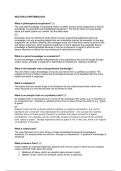Summary
Summary OCR A-Level Psychology: Themes Through Core Studies (H567): Evaluation of Biological Area, Comparisons of Studies, Key Words, Flashcards
- Course
- Institution
- Book
This Document Includes: - A full DETAILED SUMMARY of the Area - The Key Principle - Applications - Strengths/Weaknesses of the Area - Comparisons of 4 Studies (Milgram, Bocchiaro, Piliavin, Levine) - Key Words - Social, Cultural, Individual Diversity - A link to a Quizlet flashcard set
[Show more]












